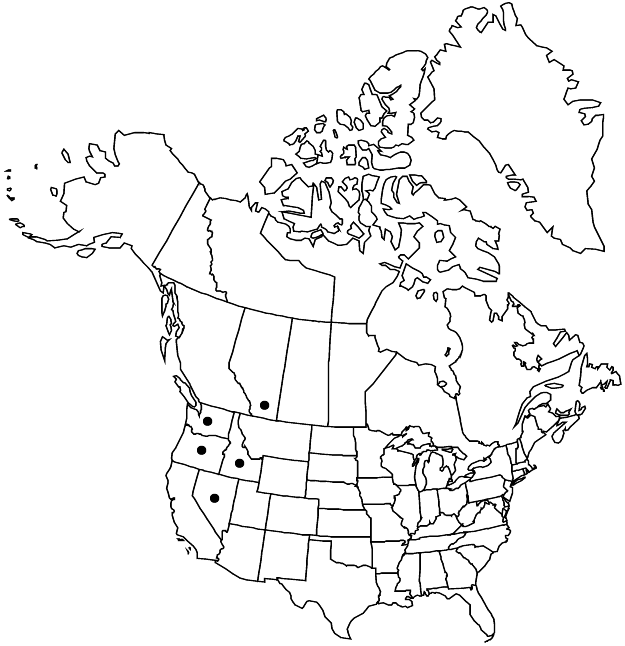Difference between revisions of "Eremogone congesta var. prolifera"
Sida 21: 239. 2004.
FNA>Volume Importer |
FNA>Volume Importer |
||
| Line 7: | Line 7: | ||
|year=2004 | |year=2004 | ||
}} | }} | ||
| − | |basionyms={{Treatment/ID/ | + | |basionyms={{Treatment/ID/Basionym |
|name=Arenaria congesta var. prolifera | |name=Arenaria congesta var. prolifera | ||
|authority=Maguire | |authority=Maguire | ||
| + | |publication_title=Bull. Torrey Bot. Club | ||
| + | |publication_place=74: 47. 1947 | ||
}} | }} | ||
|synonyms={{Treatment/ID/Synonym | |synonyms={{Treatment/ID/Synonym | ||
| Line 32: | Line 34: | ||
|elevation=500-900 m | |elevation=500-900 m | ||
|distribution=Alta.;Idaho;Nev.;Oreg.;Wash. | |distribution=Alta.;Idaho;Nev.;Oreg.;Wash. | ||
| − | |discussion=<p>We consider <i></i>var.<i> glandulifera</i> to be a glandular extreme of <i></i>var.<i> prolifera</i>. It is known from a single specimen (Ownbey & Ownbey 2763, NY) collected in Valley County, Idaho, in 1946. While most specimens of <i></i>var.<i> prolifera</i> are glabrous, the pubescence on the stems and pedicels of a collection from Douglas County, Washington (Hitchcock 17459, WTU) closely approaches that seen on the type of <i></i>var.<i> glandulifera</i>.</p> | + | |discussion=<p>We consider <i></i></i>var.<i><i> glandulifera</i> to be a glandular extreme of <i></i></i>var.<i><i> prolifera</i>. It is known from a single specimen (Ownbey & Ownbey 2763, NY) collected in Valley County, Idaho, in 1946. While most specimens of <i></i></i>var.<i><i> prolifera</i> are glabrous, the pubescence on the stems and pedicels of a collection from Douglas County, Washington (Hitchcock 17459, WTU) closely approaches that seen on the type of <i></i></i>var.<i><i> glandulifera</i>.</p> |
|tables= | |tables= | ||
|references= | |references= | ||
| Line 56: | Line 58: | ||
|publication year=2004 | |publication year=2004 | ||
|special status= | |special status= | ||
| − | |source xml=https://jpend@bitbucket.org/aafc-mbb/fna-data-curation.git/src/ | + | |source xml=https://jpend@bitbucket.org/aafc-mbb/fna-data-curation.git/src/f6b125a955440c0872999024f038d74684f65921/coarse_grained_fna_xml/V5/V5_126.xml |
|subfamily=Caryophyllaceae subfam. Alsinoideae | |subfamily=Caryophyllaceae subfam. Alsinoideae | ||
|genus=Eremogone | |genus=Eremogone | ||
Revision as of 20:07, 24 September 2019
Stems 15–25 cm, glabrous to stipitate-glandular. Leaves: basal blades mostly erect, filiform, (2–)3–8 cm × 0.3–0.7 mm, herbaceous. Inflorescences subcapitate, subcongested to proliferating cymes; bracts scattered within inflorescence. Pedicels 1–6(–15) mm, glabrous or sometimes stipitate-glandular. Sepals weakly to conspicuously 1–3-veined, (4.5–)5–6 mm, apex acute to acuminate or spinose, glabrous or glandular.
Phenology: Flowering late spring–summer.
Habitat: Sagebrush plains and slopes
Elevation: 500-900 m
Distribution

Alta., Idaho, Nev., Oreg., Wash.
Discussion
We consider var. glandulifera to be a glandular extreme of var. prolifera. It is known from a single specimen (Ownbey & Ownbey 2763, NY) collected in Valley County, Idaho, in 1946. While most specimens of var. prolifera are glabrous, the pubescence on the stems and pedicels of a collection from Douglas County, Washington (Hitchcock 17459, WTU) closely approaches that seen on the type of var. glandulifera.
Selected References
None.